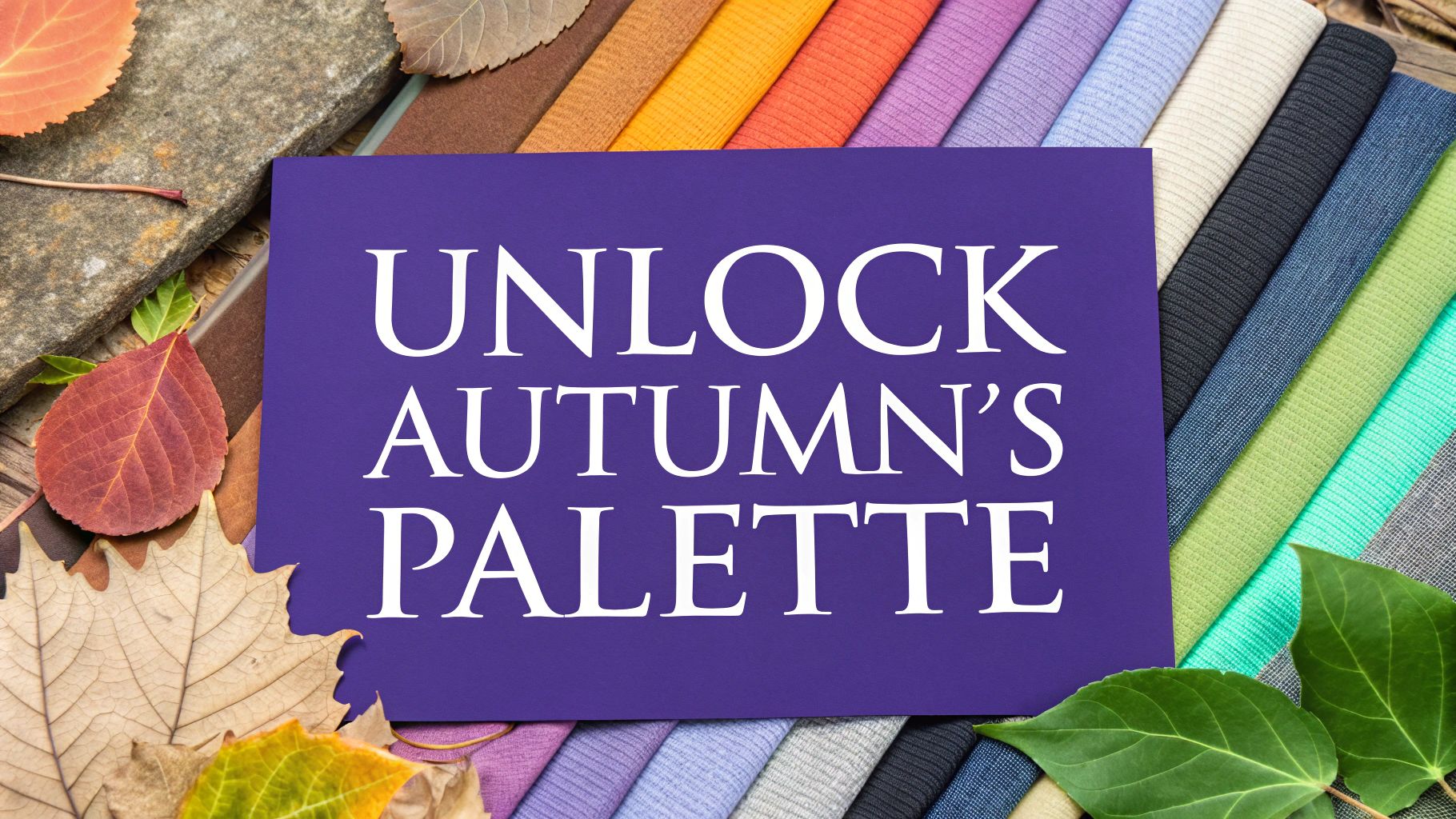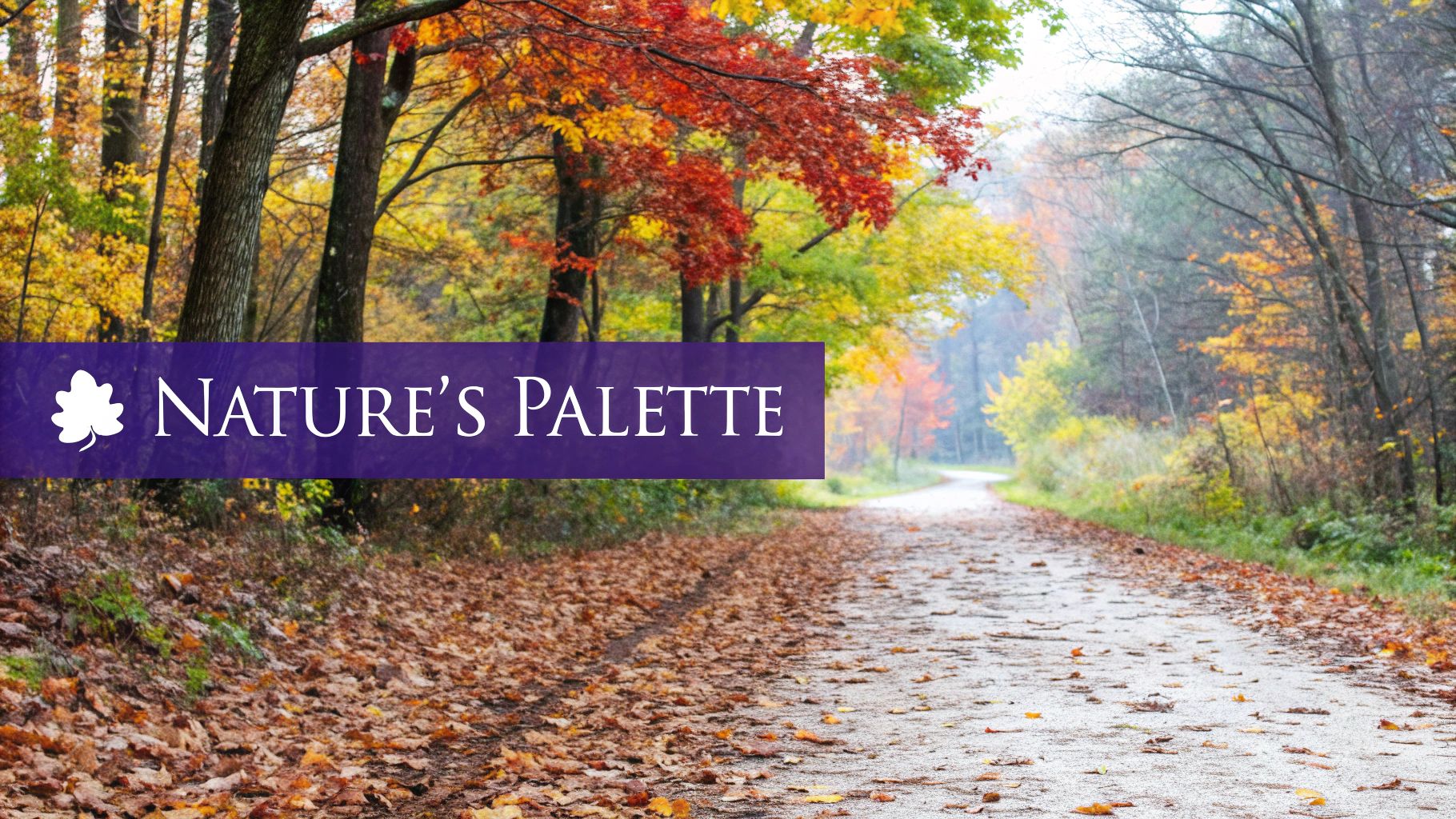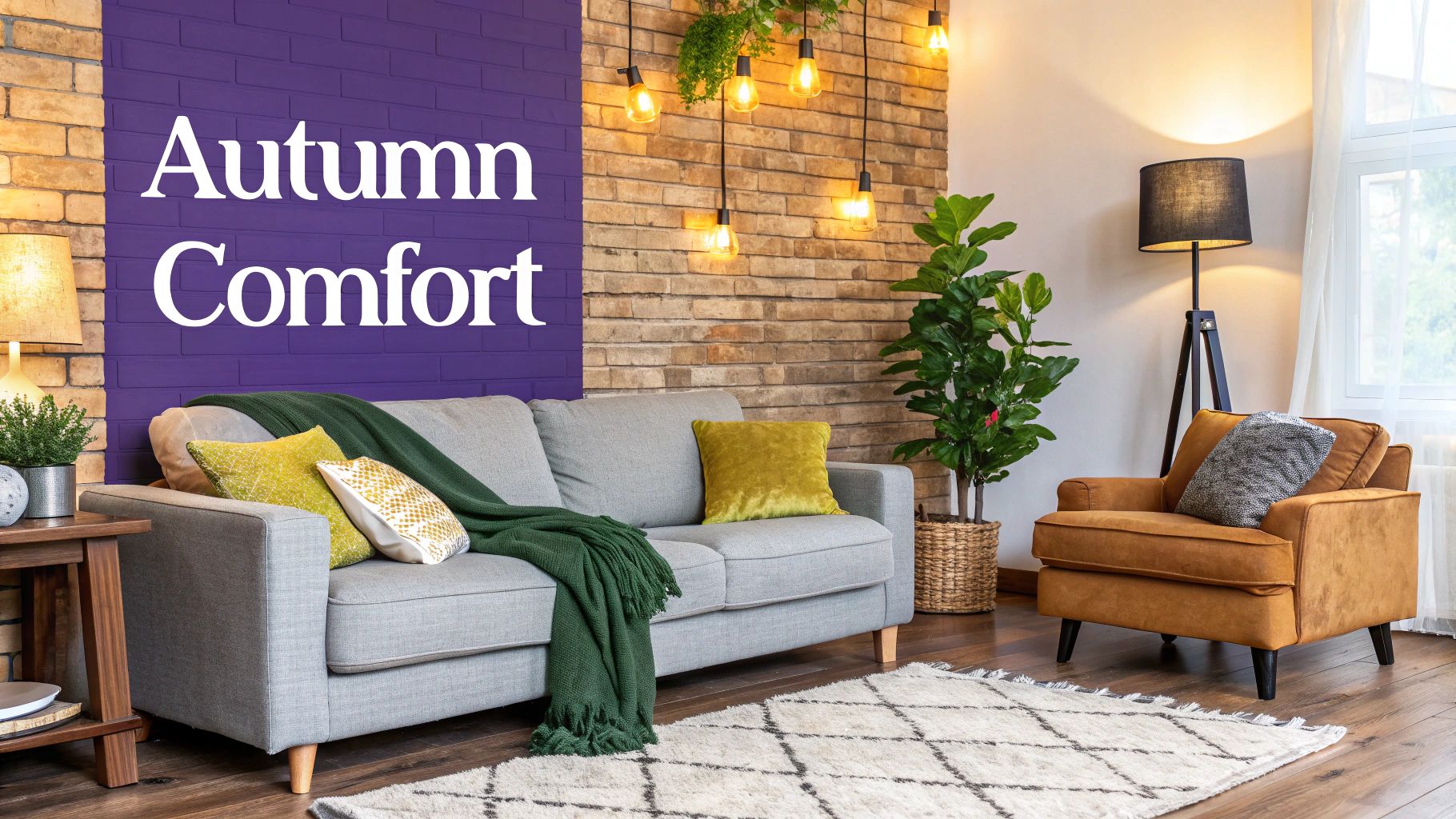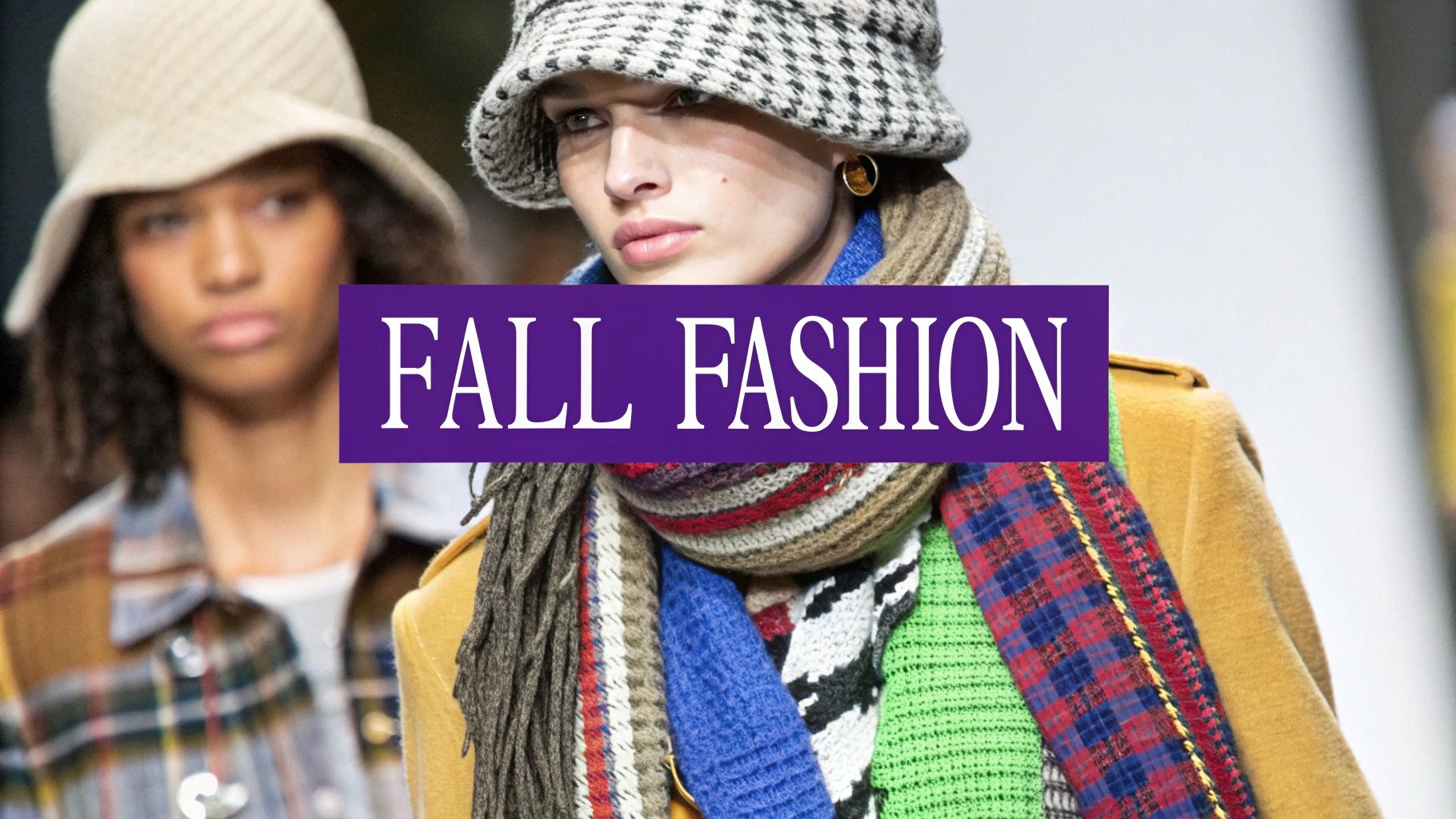
Autumn Color Analysis: The Ultimate Guide to Unlocking Your Perfect Season
By Emma Johnson - 8/15/2025
The Science and Art of Seasonal Color Analysis
Color analysis helps people find the most flattering colors for their natural features. By examining someone's skin undertone, hair color, and eye color, we can determine which seasonal color palette works best for them - Spring, Summer, Autumn, or Winter. The right colors enhance natural beauty and create a healthy, radiant appearance.
The concept of seasonal color analysis emerged in the 1980s with experts like Carole Jackson and Suzanne Caygill introducing the four-season system. The Autumn category highlights individuals with warm, rich undertones. Over time, the system evolved to include sub-categories like Deep Autumn, True Autumn, and Soft Autumn for more personalized recommendations. Learn more about color analysis here.
Understanding the Principles Behind Color Analysis
Several key elements determine how colors interact with your features. Undertone refers to the subtle hue beneath your skin's surface - warm undertones have yellow, peach or golden bases, while cool undertones show pink, blue or purple. Neutral undertones blend both. Your undertone strongly influences how colors look against your skin.
Contrast is another important factor - the difference between your hair, skin and eye colors. High contrast features might include dark hair with light skin, while low contrast means more similar tones. Your contrast level helps determine if bold or subtle colors work better. Chroma (color intensity) refines the selection further - high chroma colors are vibrant, low chroma colors appear soft and muted. Understanding these elements leads to finding your ideal autumn sub-season.
Autumn Color Analysis: A Closer Look
Autumn color analysis focuses on people with warm undertones and muted-to-deep coloring. The rich hues of fall foliage - burnt orange, deep green, warm brown, and golden yellow - often flatter Autumn types beautifully. Within the Autumn season, there are key variations:
- Deep Autumn: Best suited to rich, deep colors like teal, aubergine and dark olive green
- True Autumn: Shines in warm, golden shades including rust red, mustard yellow and medium brown
- Soft Autumn: Most flattered by muted versions of autumn colors like dusty rose, sage green and burnt sienna
By identifying your specific Autumn sub-type, you can select colors that truly enhance your features and develop a signature style that feels authentic and confident.
Mastering the Rich Spectrum of Autumn Colors

Figuring out which autumn colors work best for you can open up exciting style possibilities. The right mix of warm earth tones can complement your natural coloring beautifully. Some shades make features pop while others may detract from your natural appearance, so understanding these dynamics is key to developing a strong personal style.
The Psychology of Autumn Hues
Color choices affect both how we feel about ourselves and how others perceive us. The warm tones of autumn typically convey comfort, stability and richness. When you wear these colors thoughtfully, you not only look better but also project more confidence. By understanding the emotional impact of different shades, you can select colors that match your personality and goals. Learn more about finding your ideal colors in this color analysis guide.
Unpacking the Autumn Palette
Nature's fall display provides the inspiration for the autumn color palette - from deep reds to glowing oranges and rich browns. True Autumn colors include:
- Rust red
- Mustard yellow
- Medium olive green
- Rich browns
These shades work especially well for people with warm, golden skin undertones by creating harmony with their natural coloring. For a deeper look at autumn colors, check out this comprehensive style guide.
Creating Impactful Combinations
Learning to pair autumn colors effectively is crucial for building a cohesive wardrobe. Think of combining colors like creating art - each shade should complement the others. A color wheel can help identify winning combinations. For example, deep teal and burnt orange create appealing contrast, while various browns blend for subtle sophistication. Play with different pairings to discover unique looks that feel authentic to you.
Finding Your Perfect Autumn Sub-Season Match
The world of autumn color analysis is like exploring a beautiful seasonal palette, with each shade telling its own unique story. This guide will help you identify whether you're a Deep, Soft, or True Autumn and understand how this knowledge can enhance your personal style. By learning the subtle differences between these categories, you'll be able to make confident color choices that bring out your natural beauty.
Understanding the Nuances of Autumn Sub-Seasons
All Autumn types share warm undertones, but each sub-season has its own special characteristics. Think of it like cooking - using the same basic ingredients but adjusting the proportions creates distinctly different results.
Deep Autumn: These individuals look best in rich, intense colors. Picture the depths of an autumn forest - dark olive green, deep teal, and rich aubergine. These colors perfectly complement Deep Autumn's medium to dark skin tones and rich hair colors.
True Autumn: This type embodies classic fall colors. Think of peak autumn foliage - warm rust red, golden mustard, and toasted browns. These colors enhance the natural golden glow in True Autumn complexions.
Soft Autumn: These people shine in gentle autumn tones. Imagine early fall colors - soft rose, muted sage, and warm taupe. These subtle hues work beautifully with Soft Autumn's delicate warmth.
Determining Your Sub-Season: Practical Tips
Understanding your skin undertone is essential - you might find this guide helpful: How to master understanding your skin undertone. Once you know your undertone, you can explore autumn colors through draping - testing different colored fabrics against your face to see which ones make you glow and which ones don't work as well. You can also look to celebrities with similar coloring for inspiration.
Why Identifying Your Sub-Season Matters

The 16 Palette Color Analysis System provides detailed guidance for Autumn types and their variations. This system includes refined categories like Muted Autumn and Deep Autumn, helping color analysts give more precise recommendations. For instance, Deep Autumn people typically have medium to deep skin with warm undertones and rich hair colors - they look stunning in deep teals, aubergines, and dark olives. Learn more about this system here. When you know your sub-season, building a flattering wardrobe becomes simple and intuitive. You'll develop an instinct for which colors work best, making style choices feel effortless and natural.
Building Your Strategic Autumn Wardrobe
A well-planned autumn wardrobe allows you to look your best while making getting dressed effortless. By understanding your autumn color analysis and sub-season, you can thoughtfully select pieces that flatter your coloring and work together seamlessly.
Essential Wardrobe Foundations for Every Autumn
Start with key basics in your core autumn colors that you can mix and match easily. For True Autumns, consider items like a rust sweater, mustard blouse, olive trousers, and brown skirt. These foundational pieces form the backbone of your wardrobe.
- Neutral Base: Include warm beiges, creams and browns as versatile neutrals that pair beautifully with richer autumn tones. These create a calm foundation for outfits without overwhelming.
- Statement Pieces: Add a few special items that express your style while staying within your palette. A Deep Autumn might choose a teal blazer or a burnt orange scarf to add personality to basics.
Mastering Autumn Color Combinations
Creating flattering outfits is all about understanding how to pair colors within your autumn palette effectively.
- Color Harmony: Use complementary colors like deep teal with burnt orange for eye-catching contrast that still feels cohesive.
- Tonal Dressing: Pair different shades of the same color family, like light camel with chocolate brown, for an elegant effect.
- Smart Accessories: Use scarves, jewelry and bags to pull looks together. Gold jewelry adds warmth while a burgundy scarf provides a rich pop of color.
Building a Sustainable Autumn Wardrobe
Creating an autumn wardrobe is about making smart choices that will serve you well over time.
- Investment Pieces: Choose high-quality items that will last. While they may cost more upfront, well-made pieces save money long-term.
- Multi-Purpose Items: Select versatile pieces you can dress up or down. A good blazer works with jeans for casual days or dresses for formal events.
- Regular Editing: Review your wardrobe periodically to identify gaps and remove items that no longer work. This helps prevent impulse purchases and keeps your closet focused on pieces you'll actually wear.
By following these guidelines, you can build an autumn wardrobe that makes you look and feel confident while simplifying your daily dressing routine.
Perfecting Your Autumn Beauty Routine

Finding your perfect autumn makeup look starts with identifying your Autumn sub-season through color analysis. When you understand which colors match your natural features, you can build a makeup routine that brings out your best. Let's explore how to select and apply makeup that works beautifully for Autumn color types.
Foundation Matching for Autumn Skin Tones
The right foundation creates a flawless canvas. Autumn complexions need foundations with warm undertones - look for yellow, peach or golden bases rather than pink or cool tones that can clash with your natural warmth. Take time to test several shades to find one that disappears seamlessly into your skin.
Lipstick Shades That Brighten Your Complexion
The perfect lipstick can light up your whole face. Each Autumn sub-season has its most flattering shades:
- True Autumns: Wear rust reds, burnt oranges, and terracotta
- Deep Autumns: Look radiant in burgundy and deep berry
- Soft Autumns: Shine in dusty rose and muted peach
Eye Makeup for Autumn Eyes
Play up your eyes with rich earth tones. Bronze, gold and copper create warmth, while forest green, olive and brown add definition. A Soft Autumn might choose sheer sage shadow with brown liner, while Deep Autumns can rock dramatic smoky eyes in emerald and charcoal.
Addressing Common Makeup Challenges for Autumns
Finding the right blush and bronzer tones can be tricky. Skip cool pink blushes in favor of warm peach, brown or terracotta. Choose matte bronzers over shimmery or orange-toned ones. You might be interested in: How to master the importance of eye and hair color in a personal color analysis. For eyeshadows that don't look muddy, invest in high-quality pigmented formulas.
Creating Everyday and Special Occasion Looks
Your autumn color palette works for any occasion. For daily wear, enhance your features with subtle washes of color. Special events call for bolder lips, dramatic smoky eyes, or tasteful shimmer. The key is choosing colors that complement rather than compete with your natural beauty, helping you look effortlessly polished.
Expanding Your Autumn Influence Beyond Fashion

Color analysis goes beyond just picking out clothes - it can enhance many aspects of your life. When you understand which colors work best with your natural features, you can create visually appealing spaces and experiences everywhere. From your home environment to your personal brand, these color principles can make a real difference.
Creating an Autumn-Inspired Home Environment
Your living space should make you feel instantly comfortable and at peace. By bringing autumn colors into your home décor, you can craft a wonderfully inviting atmosphere. Rich browns, forest greens, and warm oranges work together to create a cozy feeling. Simple changes like adding throw pillows, blankets, or artwork in these shades can transform a room without requiring major renovations.
Projecting Confidence Through Color in Your Professional Life
The right colors can give you an edge in your career. When you wear flattering autumn shades to important meetings or presentations, you naturally project more confidence. Consider using these colors strategically in your work materials too. Earth-toned visual aids can make your presentations more engaging and memorable for your audience.
Autumn Colors and Personal Branding
Your personal brand should reflect who you are authentically. Autumn colors can help create a cohesive visual identity across your marketing materials, website, and social media. For example, using terracotta backgrounds or golden yellow accents creates a distinctive look that matches your natural palette. This consistency helps people recognize and remember your brand.
Practical Applications for Everyday Life
Understanding your best colors helps with daily choices big and small. From picking stationery to choosing vacation destinations, your autumn palette can guide these decisions. Even small touches of your ideal colors can improve your mood and energy. Something as simple as choosing a warm beige notebook instead of a bright blue one can create a more pleasant daily experience.
Ready to unlock the full potential of your Autumn colors? Discover your perfect colors with AI Color Analysis.
Take your style to the next level with a professional analysis
You already know the theory. Now discover exactly which colors and styles enhance your personal image.
Loading...
Complete PDF report in less than 5 minutes
Your color season and personalized palette
Specific makeup and clothing recommendations
Based on professional color analysis
One-time investment:
One-time payment, no subscriptions. Instant access.